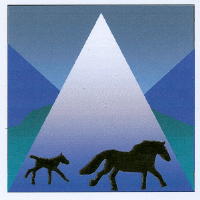Beyond Evidence-Based Horsemanship
/When I first learned about evidence-based horsemanship a few years ago, I was surprised by my initial adverse reaction. I am a scientist/engineer by training. Normally I’m quite open to scientific explanations for things we see in the world, especially when they help us understand the world better and very much especially when it comes to interacting with equines. I have learned enough about myself over the years, though, to know that if I have a visceral reaction to something, either positive or negative, it’s best to pay attention. So I didn’t pursue study of evidence-based horsemanship after that first encounter.
How my ponies choose to interact/communicate with me, or not, is a source of constant fascination for me, now much more interesting than more conventional horsemanship. that I used to practice.
Fast forward to now when a friend brought up Dr. Steven Peters in the context of his understanding of the human brain. She also mentioned that he had studied the horse’s brain. It turns out that he partnered with Martin Black, Mark Rashid, and others, lending his research credentials to what those horsemen have learned from experience to create books and DVDs about evidence-based horsemanship.
I was intrigued enough this time to search for more information, and I fortunately found a podcast conversation with Dr. Peters on Warwick Schiller’s Journey On podcast. (1) I tend to view the horsemanship world similarly to Schiller, so I was hopeful about what I might hear in his conversation with Dr. Peters. It far exceeded my expectations.
Dr. Peters is now retired from his research career where he felt he needed to provide citations of research studies for everything that he said. He acknowledged that for him now, what fascinates him is way beyond teaching a horse to more effectively let him open a gate mounted or to side-pass better. It’s about how they choose to interact with him as another sentient being. Schiller shared similarly, saying it’s not about training; it’s something way beyond that. It’s not training, it’s communicating. Schiller has found it to be a game changer.
Dr. Peters talked about using a heart rate variability monitor to assess physiologically how a horse responds to training cues. He has concluded that lick and chew, so often assumed to be an indication of understanding, is only the very, very beginning and you have to give it a lot more time to integrate into the whole body before relaxation really happens and thence understanding.
Schiller said that a friend of his who is a horse trainer has had to quit training horses because she couldn’t do what the horses needed in the timeframe given by the owners. I could completely relate. I am often asked when a weanling will be ready to travel to its new home. I will know when that point is, but each foal takes their own time telling me the date on the calendar! I can no longer in good conscious make a particular date happen until I know the foal is already ready. Schiller used to train horses but is now in the business of training owners to train their own equines because he has found that a safe and fulfilling partnership requires both parties to learn in order to work together.
Dr. Peters concluded by saying what I have witnessed in my own work. Science grows on ideas but it takes time for evidence to catch up. Often several years after my ponies have put an idea in my head, I will see a report on research that corroborates the lesson. Which is why I initially balked at the idea of evidence-based horsemanship. Just the name suggested that what I was experiencing was beyond evidence-based horsemanship. Like Schiller and Dr. Peters have found, how my ponies choose to interact with me on their own terms is much more thought-provoking and joyful than more performance-oriented activities that I used to enjoy with them. I’m grateful to be a student of pony teachers!
© Jenifer Morrissey, 2025



